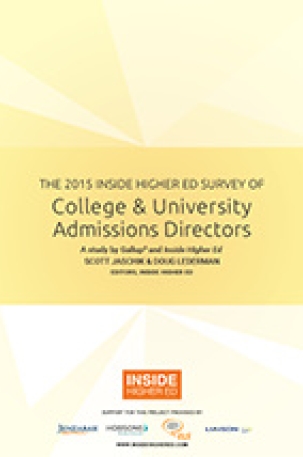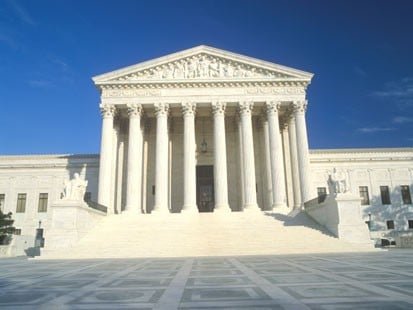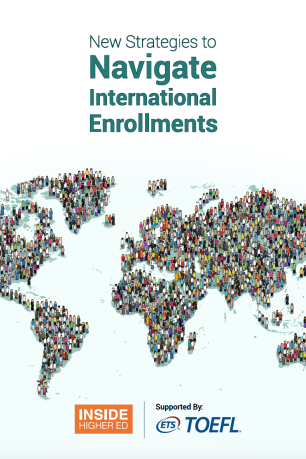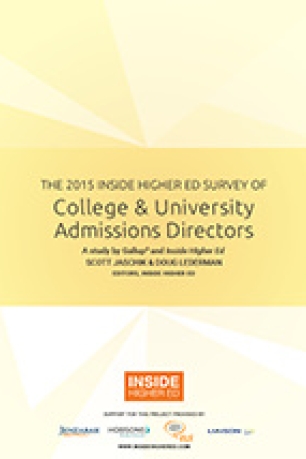Free Download

The challenges facing college admissions leaders just keep growing. As has been the case in recent years, many colleges struggle to fill their classes, according to the 2015 Inside Higher Ed Survey of College and University Admissions Directors.
But in a year full of admissions news and controversy, the poll suggests additional points of tension that have been lingering behind the scenes (pressure from higher-ups to admit applicants), are major societal issues (student loan debt) or could be about to emerge with new force (the legal battle against the consideration of race in admissions). It is no surprise that admissions leaders will have much to talk about when they arrive today in San Diego for the annual meeting of the National Association for College Admission Counseling.
Among the key findings:
- Half of admissions directors (51 percent) said they were very concerned about meeting their enrollment goals for the 2015-16 academic year, and 58 percent say they did not meet their goals. These figures mark the third straight year of a majority of admissions directors reporting high stress and uneven success at filling their classes.
- Just over three-quarters of admissions directors -- with even greater levels in private higher education -- think their institution is losing applicants because of concerns about student debt.
- At a time of growing political and public support for the idea of debt-free college, a solid majority of admissions directors believe that debt up to $30,000 is reasonable for a four-year degree. (That's a little higher than the current national average of around $28,000 for those who borrow). But as on many issues, admissions directors would set different limits at public and private colleges.
- About one in four admissions directors report that they have been pressured by senior administrators, trustees or development officials to admit certain applicants. (That's a practice many admissions directors believe is flat-out wrong, even if it will help the college politically or financially.)
- With the Supreme Court about to hear a case that could give the justices the ability to restrict or bar the consideration of race in admissions, most admissions directors do not see danger to their institutions, and most have not planned for the possibility of admissions without affirmative action. Most admissions directors back the consideration of race and ethnicity in admissions.
About the Survey
Inside Higher Ed's 2015 Survey of College and University Admissions Directors was conducted in conjunction with researchers from Gallup. Inside Higher Ed regularly surveys key higher ed professionals on a range of topics.
On Thursday, Oct. 15 at 2 p.m. Eastern, Inside Higher Ed will present a free webinar to discuss the results of the survey. Sign up here.
The Inside Higher Ed survey of admissions directors was made possible in part by advertising from ELS Educational Services, Hobsons, Jenzabar and Liaison International. end of fact box.
- Most admissions directors are skeptical of some of the new approaches to admissions started by colleges in the last year.
- Recruiting international students remains key to many admissions directors' plans to fill their classes. So does recruiting out-of-state domestic students -- despite a backlash some public colleges are experiencing on the issue.
- Despite growing criticism of the criminal justice system and the way disciplinary or legal records can follow young people into the admissions process, a majority of admissions directors favor consideration of such information.
- Fully a third of admissions directors favor adding a voluntary question about sexual orientation or gender identity to applications. That's up from 22 percent in 2012.
- Every community college admissions director polled said that there are potential students in his or her area who don't enroll for lack of funds.
The results come from answers from 264 admissions directors (or officials with equivalent titles). Those responding were given complete anonymity, but their answers were coded by institution to provide for analysis by sector.
'Affirmative Action for the Advantaged'
Admissions officers (and their institutions) have a range of views on the qualities to look for in applicants. But most argue that admissions officers should be making those decisions on the basis of established criteria, not to favor the wealthy or powerful.
 But in February 2015, an independent investigation revealed that Bill Powers (at right), then president of the University of Texas at Austin, had overruled his staff to admit well-connected students. As many as 73 undergraduates at UT-Austin in the past six years, and perhaps a handful at the university’s law school, were admitted despite grades and test scores that were substantially below those of other admitted students. Of these, some had ties to lawmakers or alumni.
But in February 2015, an independent investigation revealed that Bill Powers (at right), then president of the University of Texas at Austin, had overruled his staff to admit well-connected students. As many as 73 undergraduates at UT-Austin in the past six years, and perhaps a handful at the university’s law school, were admitted despite grades and test scores that were substantially below those of other admitted students. Of these, some had ties to lawmakers or alumni.
The report spurred considerable debate among admissions professionals, some of whom expressed anger that such interference would happen even once, and others saying that this sort of pressure should be much rarer than apparently was the case at Texas. The report blasted the presidential interventions as "affirmative action for the advantaged."
Inside Higher Ed's survey asked the admissions directors whether they had experienced various forms of pressure from outside the admissions infrastructure. The results suggest that even if what happened at Texas is not the norm, there is plenty of pressure being placed on admissions directors nationally on behalf of well-connected applicants. About one in four -- with substantially higher numbers at private colleges -- reported such influence.
Percentage of Admissions Directors Reporting Pressure to Admit Applicants
| Percent reporting pressure by … | All | Public | Private |
| Senior-level administrators | 24% | 18% | 29% |
| Trustees | 22% | 11% | 29% |
| Development officials | 26% | 15% | 32% |
Development officials were the most likely source of pressure, with 32 percent of admissions directors at private institutions reporting such pressure.
 When the Texas admissions scandal broke, some in higher education said that ethical purists were making too much of what goes on regularly (on a small scale) to the betterment of higher education. To measure support for that idea, Inside Higher Ed asked the admissions directors to respond, on a 1-to-5 scale, to two statements.
When the Texas admissions scandal broke, some in higher education said that ethical purists were making too much of what goes on regularly (on a small scale) to the betterment of higher education. To measure support for that idea, Inside Higher Ed asked the admissions directors to respond, on a 1-to-5 scale, to two statements.
As in the above data, a public-private difference is clear, with private admissions deans more tolerant of requests to admit certain applicants. For example, 60 percent of public admissions directors believe it is never appropriate for a president to lobby on behalf of an applicant, but only 32 percent of private admissions directors share that view.
And while 35 percent of private admissions directors believe that, in moderation, it is appropriate to respond to such requests to promote financial support for their institutions, only 11 percent of public institutions share that view.
The tables shows the two statements and the breakdowns:
Statement: It is never appropriate for a president, a board member or a high-ranking official to lobby on behalf of an applicant.
| Public | Private | |
| 5 (strongly agree) | 46% | 20% |
| 4 | 14% | 12% |
| 3 | 20% | 26% |
| 2 | 12% | 29% |
| 1 (strongly disagree) | 7% | 14% |
Statement: Responding to pressure from high-ranking officials to admit certain applicants, in moderation, is a reasonable way to promote financial support for my institution.
| Public | Private | |
| 5 (strongly agree) | 3% | 8% |
| 4 | 8% | 27% |
| 3 | 22% | 29% |
| 2 | 19% | 12% |
| 1 (strongly disagree) | 48% | 24% |
The Supreme Court and Affirmative Action
 Most admissions leaders strongly support the right of colleges to consider race and ethnicity in admissions decisions. But the Supreme Court in the term that starts this month will be considering a case involving UT-Austin that could give the justices a chance to restrict or bar the consideration of race by colleges and universities.
Most admissions leaders strongly support the right of colleges to consider race and ethnicity in admissions decisions. But the Supreme Court in the term that starts this month will be considering a case involving UT-Austin that could give the justices a chance to restrict or bar the consideration of race by colleges and universities.
While the case is most directly focused on admissions decisions, a ruling could affect a range of other programs -- including financial aid, special summer programs for members of certain ethnic, racial or gender groups, and so forth.
While many Supreme Court observers are expecting an anti-affirmative action majority to decide the case, the survey of admissions directors found only moderate levels of concern.
Twelve percent of admissions directors said they were very concerned about the outcome of the case, while another 27 percent were moderately concerned. Nearly a third -- 32 percent -- were not concerned at all.
Only a minority of admissions directors (15 percent at public institutions and 2 percent at privates) have developed plans for the possibility that the Supreme Court limits or bans the consideration of race. While others say they are talking about the issue, 61 percent of public institution admissions directors and 76 percent of private institution admissions directors said they hadn’t had any discussions about responding to a Supreme Court ruling unfavorable to affirmative action.
Asked about policies their institutions would likely adopt if unable to consider race and ethnicity in decisions, admissions directors didn’t have a consensus strategy, but indicated a range of possible policy shifts.
Admissions Directors Agree or Strongly Agree on Strategies
If Limits Are Placed on Consideration of Race
| Policy | Public | Private |
| More consideration of first-generation status | 28% | 30% |
| More consideration of socioeconomic status | 28% | 25% |
| Adopt noncognitive measures | 30% | 32% |
| Drop standardized test requirements | 4% | 17% |
| Adopt policy of admitting top % of high school graduating classes | 13% | 6% |
| Drop admissions preferences for alumni children | 15% | 4% |
Do Asian Applicants Receive Fair Treatment?
One issue increasingly debated with affirmative action is the claim that Asian applicants are held to higher standards than are other applicants. The argument was made by advocates for Asian-American groups in a complaint filed with the Education Department about Princeton University. And while the department last month cleared Princeton, the issue remains and has been cited in briefs urging the Supreme Court to limit the consideration of race in admissions.
Admissions directors in the survey had an interesting response to the issue: only 1 percent of admissions directors at private institutions admitted to holding Asian applicants to a higher standard, and none at public institutions did so.
But asked if they believe colleges are holding Asian applicants to a higher standard, 51 percent at private institutions and 33 percent at public institutions said yes.
Skepticism on New Approaches
While some admissions directors said they were open to using noncognitive measures in the admissions process, most were not impressed with new approaches introduced in recent years by liberal arts colleges.
The directors were asked about these approaches in questions that described the idea, but not the college that has adopted it (although we'll name the colleges here). For example, Goucher College has started admitting students based on a two-minute video and some graded work from high school -- no test scores required and no high school transcript. Only 16 percent of admissions directors said that was a good or very good idea, while 51 percent said it was a bad idea or a very bad idea.
Bennington College has opted to let applicants design their own application and submit what they think is best. As at Goucher, high school transcripts aren't required. Admissions directors were skeptical of this idea, just as they were of Goucher's. Only 5 percent of directors at public institutions and 6 percent at private institutions thought it was a good or very good idea. But 80 percent of public institution directors and 77 percent of private institutions thought it was a bad or very bad idea.
Responses to another question may reveal why there is so much skepticism. Asked if it was ever appropriate to admit students without requiring the high school transcript, only 31 percent of admissions directors at public institutions and 20 percent at private institutions said it was.
Views on Debt From the Admissions Office
The growing national debate about student debt levels is clearly on the radar of admissions directors -- as a source of considerable frustration. Seventy-six percent of admissions directors report that they are losing potential applicants because of their concerns about debt levels. The concerns are much greater at private institutions (87 percent) than at public ones (57 percent).
But while Hillary Clinton, Bernie Sanders and Elizabeth Warren are talking about debt-free public higher education, very few admissions directors share that vision. They think some debt is reasonable, but they differ (again, with public and private diverging) on how much debt is reasonable.
A majority of admissions directors at public institutions believe that debt should not exceed $20,000 for a four-year degree, while a majority of private college admissions directors accept more than $20,000 as a reasonable debt level. And while only 2 percent of admissions directors at public institutions see debt in excess of $40,000 as reasonable, 13 percent of admissions directors at private institutions do.
Admissions Directors on Reasonable Debt Levels for Four-Year Degree
| Public | Private | |
| No debt at all | 2% | 0% |
| < $5,000 | 5% | 0% |
| $5,000 to < $10,000 | 22% | 2% |
| $10,000 to < $20,000 | 37% | 20% |
| $20,000 to < $30,000 | 25% | 41% |
| $30,000 to < $40,000 | 7% | 24% |
| $40,000 to < $50,000 | 1% | 9% |
| $50,000 or more | 1% | 4% |
The Enrollment Targets and the Backlash
For many colleges and universities, international students and out-of-state domestic students are a key part of their strategy, as has been the case in recent years.
 Solid majorities of admissions directors (55 percent at public institutions and 63 percent at private institutions) said they plan to increase efforts to recruit international students in the next year. The significance there is the word “increase,” in that so many colleges have been upping recruiting efforts in recent years for students from outside the United States.
Solid majorities of admissions directors (55 percent at public institutions and 63 percent at private institutions) said they plan to increase efforts to recruit international students in the next year. The significance there is the word “increase,” in that so many colleges have been upping recruiting efforts in recent years for students from outside the United States.
Related to the international interest, 32 percent of admissions directors over all said that they were using “pathways” programs, in which some international students who may not have yet reached English proficiency sufficient for full-time enrollment in college-level work come to the United States to learn English and, in some cases, start some college courses.
This approach could be growing, as 30 percent of those without such programs are considering such relationships.
International students are of course one subset of “out-of-state” students. And here again, despite significant moves in this direction in recent years, most admissions directors say they plan to do more recruiting out of state.
Asked if they plan more recruiting out of state in the next year, 58 percent of admissions deans at public institutions strongly agree that they will do so, and another 29 percent agree. For private institutions, the numbers were 64 percent strongly agreeing and 24 percent agreeing. The latter figures reflect the reality that many private colleges (excepting the highly competitive ones) don’t recruit nationally and rely on local populations, or have done so historically.
Given the widespread goal of colleges to recruit more out-of-state students, Inside Higher Ed added questions this year on whether the strategy is succeeding, and whether it is creating a backlash. Several prominent public universities, such as the University of Iowa, have faced pressure from state officials to increase their in-state populations.
The answers indicate that most public colleges and universities have been seeking more out-of-state students, that they think they have been succeeding and that most haven't seen a backlash. (The second and third questions in the table that follows were not asked of those whose institutions have not had such a strategy, and this set of questions was asked only of admissions directors of public institutions.)
Admissions Directors on Out-of-State Admissions
| Question | Yes |
| In recent years, has your college sought more out-of-state students? | 68% |
| Have your college's efforts to seek more students been successful? | 86% |
| Is your college facing political or public scrutiny over admitting more out-of-state students? | 21% |
Disciplinary Records, Fairness and Training
Amid a growing debate in the United States over whether elementary and secondary schools, and police forces, treat young black and Latino men and women fairly, some groups have been urging colleges to reconsider whether it is appropriate to regularly request information on disciplinary and legal records of applicants. A report in May from the Center for Community Alternatives urged colleges to stop requesting these records.
Further, it said, if colleges do request the records, they need to provide good training for admissions officers so they know when a minor infraction by a high school freshman -- or any infraction, if there is evidence of bias -- shouldn't be viewed as serious cause for concern.
The report caused some soul searching and considerable debate among admissions officers, some of whom defended their use of disciplinary records.
Inside Higher Ed added questions to the survey this year in light of this interest, and found admissions directors at many colleges (a majority at private institutions) do request such records and only a minority have training for staff members on how to evaluate the information they obtain. On the table that follows, note that the second and third questions were asked only of admissions directors at colleges that do collect the information.
Applicant Disciplinary Records: Current Policy
| Question | % Yes From Public Higher Ed | % Yes From Private Higher Ed |
| Does your college seek information, either from applicants or high schools, about whether applicants have a legal or disciplinary record? | 40% | 77% |
| Is your colleges reconsidering whether such information is appropriate to gather? | 11% | 8% |
| Does your institution provide special training for admissions officers to know how to evaluate such information? | 47% | 41% |
Then Inside Higher Ed asked the admissions directors what they think policy should be.
Applicant Disciplinary Records: What Policy Is Desirable?
| Statement | % Yes From Public Higher Ed | % Yes From Private Higher Ed |
| Institutions should not ask any questions about applicants' legal or disciplinary records. | 11% | 1% |
| Institutions should limit the scope of such questions (for example, asking only about recent incidents or violent incidents). | 46% | 30% |
| Institutions should ask all applicants to report all disciplinary or legal infractions. | 43% | 68% |
As the above table shows, admissions directors at private colleges are much more willing than their public counterparts to use and defend the need for access to disciplinary records. But even among private college officials, a significant minority are open to limiting the scope of such questions.
Community College Admissions Issues
Much of the discussion about admissions focuses on four-year institutions, and elite colleges at that. But there are also significant issues facing community college admissions leaders, and Inside Higher Ed asked them a series of questions. Some of the results:
- Asked if the discussion of President Obama's proposal for free community college has generated increased interest in their institutions, 41 percent said yes. Asked if there are potential students in their community who don't enroll because of lack of funds, 100 percent said yes.
- Admissions directors report a range of experiences on the enrollment of traditional-age college students: 34 percent of directors have seen an increase in this population in the last year, while 41 percent have seen a decrease and 25 percent have not seen a change.
- Most community college admissions directors reported that their institutions do see competition for students from for-profit colleges. Eleven percent said that they saw a lot of competition and 62 percent saw some competition.



